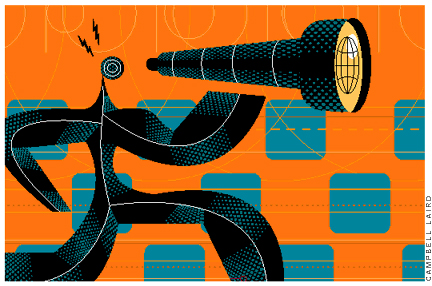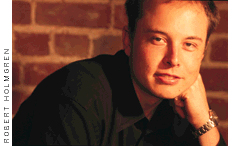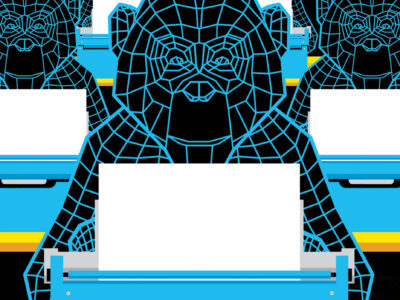
How would-be experimental physicist became a cyber-mogul instead.
By Phil Leggiere | Illustration by Campbell Laird
Sidebar: Opportunities Online
Looking over his curriculum vitae, you’d imagine that Elon Musk C/W’95 must have roared out of West Philadelphia four years ago with his sites squarely set on quickly amassing millions: Barely 28 years old, he is a full-fledged Silicon Valley cyber-mogul who’s already sold his first Internet company—Zip2 Corporation—for more than $300 million and is now poised to launch what may become the world’s premier virtual financial-services company—the Amazon.com of personal finance.
Actually, as the South African-born Musk tells the tale, the first decision he made after collecting his degree in finance was to quit the field and swear off business completely. “I wanted to have a sense I was working on something having a fundamental impact on people’s lives, and going to Wall Street or into a large corporation, I became sure, was not going to be a way of doing that,” he recalls.

Real impact, Musk decided, meant high-energy physics, which he pledged to take up professionally. If all had gone according to his plan at the time, this article would be a portrait of the ex-business student as experimental physicist, struggling to perfect his pet technological breakthrough in power generation—an advanced high-energy storage device capable of replacing batteries, an “ultra-capacitor,” about which Musk still waxes rhapsodic. “High- energy physics is where some major technical revolutions are going to come from,” he predicts. “By getting down to the quantum plane, it’s going to make much more power available more cheaply and with less pollution.”
A funny thing happened on the way to the ultra-capacitor lab, however. In the summer of 1995, as Musk was getting geared up to begin doctoral work in physics at Stanford University, he found himself captivated by another, at that time new, technology—one he believed, and still believes, will be seen centuries from now as the most important development of our time. It was the World Wide Web, itself the creation of the physics-research community.
“I don’t remember one great Aha moment, when I suddenly had some grandiose commercial vision—that classic story entrepreneurs are supposed to have,” he says. “What happened was, in working with the Web, I became absorbed by its astounding possibilities as a medium which could completely change the economics of the delivery of printed information. It’s become a bit of a cliché recently to talk of it as a breakthrough as important as the Gutenberg printing press, but that doesn’t make it any less astounding. Or less true. It was hard not to try and see if I could push it forward.”
So, less than a week into the doctoral program Musk decided to put high-energy physics aside, at least temporarily, and throw his energies into a business plan. His idea? To develop software code allowing newspapers to take advantage of the new medium to link readers with local merchants. “What Elon saw, ahead of everyone,” observes Steve Outing, columnist for Editor and Publishermagazine, “was that presenting local content and classified ads on the Web involved a radical rethinking of how to present information interactively. Many newspapers were anxious to put sites up on the Web but really didn’t have a clue how to do it right. Elon’s innovations were important to helping companies like The New York Times start to make the transition.”
“It was a tough decision,” Musk admits. “I’m not a born risk taker. I also had a scholarship and financial aid, which I’d lose. Being young helped. So did the fact that the field was literally brand-new, with no experts. But I’m a realist, so I hedged it and took a deferred admission from September to January.” The chairman of the department, Musk adds, “who’s seen Valley start-ups come and go, and knows that most fail, said, ‘Well, give it a shot, but I’ll bet we’ll see you in three months.’” Musk hasn’t been back since.
In the fall of 1995—centuries ago in Net time, when Amazon.com was just a gleam in Jeff Bezos’ eye and Yahoo! a student hobby—Musk holed up in a windowless $200-a-month Palo Alto flat and began a year of doing the classic Silicon Valley start-up shuffle—going from one venture-capital firm to the next to scrounge up funding for his new venture, to no avail. Finally, in 1996, after the wildly successful Netscape initial public offering (IPO) set off shockwaves in the financial world and prompted a mad rush for all things Web-related, Zip2 found its first backer in the venture firm Mohr, Davidow. “They must be crazy. Do they have any idea what they’re doing giving me all this money?” Musk remembers thinking, after the firm fronted him the back-then-unbelievable sum of $3.5 million. “I was terrified of blowing that money.”
Over the next two years, though, Zip2 (www.zip2.com) more than came through for its backers. Major media companies, including The New York Times Company and the Knight-Ridder newspaper chain, began partnering with Musk to launch high-profile “City Guides,” such as the Times’ “New York Today,” that provided Web surfers with local information on restaurants, movies, concert reviews, jobs, used cars—just about everything.
In exchange for providing consultation on site development and an integrated package of content management, editorial workflow and e-commerce applications, Zip2 received hefty consulting fees, as well as transaction royalties on sales and ads generated by the sites.
Currently a $100-million-per-year market, the City Guide niche is projected to top $1 billion per year by 2002. Not surprisingly, the field has become crowded with competitors. Among those out to get Zip2 are Microsoft, with its “Sidewalk” locations; Barry Diller’s Ticketmaster, through its “City Search”; and America Online, which has launched AOL “Digital Cities.” Zip2, however, is still seen by most industry afficionados as the technology’s brand-leader.
Like most Web start-ups, Zip2 has yet to turn a profit. However, by early this year Musk had built Zip2’s network of sites to nearly 150 and brought the company’s annual revenues into the tens of millions of dollars. In February he sold the firm to Compaq Computer’s AltaVista subsidiary for a reported $305 million cash. Many employees and investors did well, but as the company’s major individual shareholder, Musk pocketed a good chunk of the money, putting him in the unexpected position of being a near centi-millionaire.
“I guess it’d be really easy for me to spend the next 40 years doing absolutely nothing, hanging out, buying an island” or playing video-games and watching the San Francisco 49ers, his favorite football team. Yet, with barely a break, Musk finds himself jumping back into the Web fray. “It’s not that I’m a workaholic, I don’t think,” he says. “Actually, I just can’t resist seeing and being a part of what’s going to unfold with the Web over the next decade or so. I’m still endlessly curious about how it will evolve. I know it’s nowhere near fulfilling its potential.”
In addition, Musk has come to realize he’s more at home as an entrepreneur than as a manager. “Something about the culture of start-ups, at least at this point in my life, seems inevitable. It’s more fun, the atmosphere is more creative, and I think more gets accomplished.” Musk also thinks the collegiality of the Silicon Valley start-up style, which eschews most traditional props of corporate authority, is the natural way to organize educated workers in knowledge-based industry. “It actually may make it harder to manage people, in that you can’t order someone to do something arbitrarily just because of who you are, but I have a gut feeling it’s more than a Silicon Valley or generational trend,” he says.
What he envisions in his ambitious new venture, called X.com (www.X.com) which is due to launch this fall, is a new generation of Internet-based financial services. While Zip2’s strategy was to partner with old-line media powerhouses, X.com, Musk says, will seek to go directly to consumers, outflanking the perennial giants of traditional banking, insurance and brokerage. “The huge brick-and-mortar financial institutions,” he explains, “the Bank of Americas, the Chase Manhattans, the Citibanks, all have gigantic investments in existing assets, which include thousands of branches, millions of tons of concrete, steel and glass, legacy information systems, and organizational boundaries between service divisions. From a consumer standpoint these make the coordination of different services into a unified package expensive, complicated and confusing.
“A really well-done, pure Internet-based service, without all that overhead baggage, could pass along enormous savings to consumers in the form of discounts,” he insists. Perhaps even more important, he believes, X.com promises to provide a truly simple, easy-to-use interface for individuals to access all facets of their financial affairs—pay bills; shop; deposit, withdraw and invest funds; obtain credit; and take out mortgages and insurance. Currently, according to the research firm Inteco of Norwalk, Conn., nearly 7 million American households access bank, stock and other financial accounts online. Within five years, Musk believes, the technology will move far more deeply into the mainstream—a view corroborated by the market-research company The Gartner Group, which in a recent survey predicted that a whopping 9 billion bills would be paid online by 2005, a more than 20-fold increase over current figures. X.com will be competing with a number of other pure Internet financial start-ups, such as Compu-Bank, Netbank and Wingspan.com, pursuing the same vision.
The irony of his return to finance doesn’t escape Musk. In fact, it seems to bemuse him. “In a certain strange way, I’m ending up back where I started—though in a radically different context I never could have predicted,” he says.
High technology has put the entire economy on its wildest ride in decades, and Musk is betting the next five to 10 years will “be just as intense in terms of technological and business change.” Still, this is one high flyer who says he’s committed to keeping in touch with reality. “Any change this profound is bound to set off speculative frenzy,” he cautions, “and people need to do their homework, and not blindly buy into companies that aren’t well put together. There are a lot of Potemkin villages out there built on flimsy foundations and many, many will fail. There’s going to be a lot of weeding out” in the future.
He also worries that many younger people, conditioned to the good times, will not be mentally prepared for a downturn. “This is the longest peacetime expansion in history, and for young people who’ve never really seen a serious recession—and anyone who’s studied history knows they happen—a downturn will be a rough experience.” Nonetheless, he emphasizes, “the radical cost advantages the Net brings are real and viable long-term.”
While many winning entrepreneurs seem to see success as a sign of moral superiority, Musk acknowledges that luck and timing are an inevitable part of the mix, however bright and hard-working you may be. He also seems at pains to keep his stratospheric rise in perspective, doubtless far from easy in the epicenter of the high-tech success ethos of Silicon Valley.
“The bottom line for me, which I don’t let myself forget, is that challenges are what drive me above all—the challenge of creating things that I hopefully will get a chance to look back on and be proud of.”
Phil Leggiere C’79 lives in Hokoken, N.J. He wrote about Constitutional scholar and Internet expert Lawrence Lessig W’83 in the Nov/Dec 1998 Gazette.
SIDEBAR
Opportunities Online
When Elon Musk C/W’95 came up with the idea of creating interactive classified ads and local entertainment and restaurants listings on the Web, he struck Internet gold—his Zip2 Corporation sold for a reported $300 million-plus early this year (see main story above). Only time will tell whether his latest venture, a planned financial-services Web site called X.com, will be equally successful, but some other Penn alumni—while not yet in Musk’s league among cyber-moguls—have carved out niches of their own on the Net.
Page-turners for Practitioners
With volumes that include EKG Pocket Survival Guide, Fluids and Electrolytes: A Practical Approach; and Mucosal Biopsy of the Gastrointestinal Tract, one might assume that an online bookstore would be hard-pressed for customers.
But that hasn’t been the case for www.MedBookStore.com, created by four Penn alumni. They honed in on required reading for thousands of doctors, nurses and health-professionals-in-training; added a 10 percent discount and next-business-day delivery; and amassed a loyal customer base faster than you can say Sphygmomanometer (they sell those, too). “This is a much faster, cheaper, easier way” of purchasing medical books, explains Sundeep Bhan C’94, the chief executive officer of Medsite.com Inc. His friends and business partners include Rajnish Kapoor W’93, chief operating officer; Sameer Shariff W’93, chief strategic officer; and Sanjay Pingle W’93, chief marketing officer.
Selling texts to time-pressed doctors is just one of the company’s ventures into e-commerce. “I think our long-term strategy is really to be the physician’s home on the Internet,” Bhan says. “We’re basically looking at their everyday needs and providing solutions to make their lives easier, and save time and money.” Already they have built upon their book trade by offering software and medical supplies, launching a medical-journal tracker to help doctors keep up with the latest news in their fields, providing an e-scheduling tool and hosting online discussions to cultivate an interactive medical community.
The business itself grew out of an idea Bhan had while taking biology during his sophomore year at Penn. At the time, he was a pre-med student; he later switched to business and communications. “I had to write some papers using Microsoft Word. It kept getting stuck on every medical term. The thought crossed my mind that somebody should make a medical spell-checker. Three or four years later, we went out and created the software.” Although Bhan and his friends eventually sold it off to another medical publisher, their efforts to market the product led to the creation in 1997 of www.medsite.com—a medical search engine which reviews other Web sites and now offers an array of products and services to health professionals. They have set their sights on a potentially huge international market.
According to Bhan, Medsite has more than 200,000 registered users from more than 60 countries; one-fifth of its revenues come from customers outside the United States. He expects the company to bring in more than $11 million this year and for its staff of 100 employees (up from 20 less than a year ago) to double within the next six months. They take up two floors of an office building at 13th and Broadway, in Manhattan’s “Silicon Alley,” and are looking for more space. “The beauty of the whole thing,” Bhan says, “is the growth is phenomenal. The excitement is unbelievable.”
Like that other, really large online bookseller, Medsite hasn’t turned a profit yet. Bhan, however, emphasizes the importance of company growth at this stage. “If we wanted to be profitable today, we could be, but we’re spending a lot of money on marketing, building our brand, and it won’t be long before we can leverage our existing customer base to bring new products and new services to them. Right now, it’s a land grab.”
Just Click, then Sniff and Sip
Looking for a hearty Argentinian Malbec for less than $10, a 1995 Bordeaux with chocolate and currant accents or simply a last-minute birthday gift for Dad? James Cawley C’91, president and founder of Directcellars.com, hopes you’ll get on the Web and browse in his store. Cawley gave up bond trading on Wall Street about a year and a half ago to start the business.
Experienced connoisseurs and novices alike can search the site for wines by color, varietal, country and price, or simply peruse the latest recommendations and selection of gift samplers. Wine reviews and a food-and-wine pairing database provide information that is typically absent from actual wine stores.
What you won’t find on these virtual shelves, however, are scores of high-priced “trophy wines” or popular supermarket sellers. “We’re not the Amazon.com of wine,” Cawley explains. “We troll the universe of wines—we have access to 35,000 for next-day delivery—and we edit them down to a list of 1,000. We go out there looking for cutting-edge wines.” His company employs two “very high-end, exciting sommeliers” who taste about 150 wines per week.
With so many e-commerce businesses popping up in every category, Cawley says, the biggest challenge is figuring out how to “drive the traffic to your site and get them to buy.” Direct Cellars’ strategy is to make wine-buying “an entertainment proposition, as well. We don’t want to be like a state-owned, stodgy wine store. We want to make it a pleasurable experience.”
In this vein, DirectCellars has begun organizing on-line wine tastings, using Real Audio broadcasts. “People will be able to pre-buy a sampler of South African reds, and we’ll bring over a wine maker from one of the [featured] wineries to talk about the harvest,” Cawley explains. “Then we’ll have a tasting where you can ‘sit’ with a few friends on a Tuesday evening” and try the wines. “We’re taking the old world of wine and blending it with the new world of the Internet.”
One Hopping Shopping Site
How do you convince customers to fill their virtual shopping carts with CDs, clothing, jewelry and even pet toys? “You need to have value and convenience combined with the familiarity of a brand consumers feel comfortable with,” says Scott Lenet WG’97. “What Internet-commerce companies need to do is make sure they provide all three things, so shopping online is superior to shopping in an outlet mall and sifting through bins or picking up the telephone and calling an 800 number.”
Lenet and his partner, Peter Bauert, believe they have achieved that winning combination with their Web site, SmartFrog.com. Customers sign up for the free service and earn cash-back rewards each time they make purchases at any of 100 online merchants, ranging from JCrew to Omaha Steaks and The Disney Store. The rewards, known as “Frog Dollars,” can be redeemed for cash twice a year.
Lenet says, “There are many ways to help and reward customers when they shop online, and we’re expanding the number of services and stores dramatically in our new release.” The next version of SmartFrog.com (the site was officially opened in February) is due to be released this fall. Lenet and Bauert, co-CEOs of the enterprise, based in Austin, Texas, brainstormed the idea while working for the technology company Trilogy. “We used to come up with about an idea a week for a business. Generally it’s easy to shoot ideas down,” Lenet explains. “There are always a ton of reasons why a business isn’t worth pursuing. But we couldn’t shoot this one down.”
—SL




